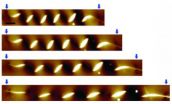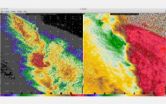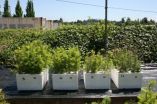Poker-faced professions take toll on employees
Organizations face trade-off: Maintain neutrality or be liked
2011-01-12
(Press-News.org) Employees who have to maintain a neutral disposition while they are on the clock tend to spend more energy to meet that requirement; therefore, they have less energy to devote to work tasks, according to new research from Rice University, the University of Toronto and Purdue University.
The researchers found that workers who must avoid appearing either overly positive or negative -- such as journalists, health care professionals, social workers, lawyers and law enforcement officers -- suppress expressions of emotion more than workers in other service-oriented professions, where the expression of positive emotions is called for.
"Our study shows that emotion suppression takes a toll on people," said Daniel Beal, assistant professor of psychology at Rice and co-author of the study. "It takes energy to suppress emotions, so it's not surprising that workers who must remain neutral are often more rundown or show greater levels of burnout. The more energy you spend controlling your emotions, the less energy you have to devote to the task at hand."
Beal and his co-authors, John Trougakos of the University of Toronto and Christine Jackson of Purdue University, found that employees will generally engage in higher levels of suppression in an attempt to adhere to the neutral display requirement to meet the expectations of their managers or the public.
Another consequence that the researchers noticed was that customers who interacted with a neutrally expressive employee were in less-positive moods and, in turn, gave lower ratings of service quality and held less-positive attitudes toward that employee's organization. The findings suggest that even though neutrality in such jobs is required for a number of reasons -- to maintain trust, to keep a situation calm, to not influence the actions of others -- it may not result in a particularly positive reaction from others.
"When an employee is positive, it transfers to the client or customer they're working with," Beal said. "Because of that good mood, the client or customer then would rate the organization better. But if an employee is maintaining a neutral demeanor, you don't have those good feelings transferred. If an organization's goal is to be unbiased, then that may trump any desire the organization has to be well-liked."
For the study, the researchers trained participants to perform as poll workers in two different conditions. In one condition, the training emphasized being positive to provide a good impression of the organization sponsoring the survey. In the second condition, the training emphasized being neutral so as not to bias the responses of survey respondents. Results supported the idea that neutral displays require greater emotion suppression and this greater suppression led to less persistence at the surveying task and greater avoidance of potential survey respondents.
While other research has focused on jobs that require the suppression of negative feelings, such as customer service representatives, this is the first such study to examine the jobs that require a neutral disposition and the consequences of suppressing both negative and positive emotions on the job.
The study, "Service Without a Smile: Comparing the Consequences of Neutral and Positive Display Rules," will be published in the forthcoming issue of the Journal of Applied Psychology.
###
To interview Beal or receive a copy of the study for news purposes, contact David Ruth, director of national media relations, at druth@rice.edu or 713-348-6327.
Located in Houston, Rice University is consistently ranked one of America's best teaching and research universities. Known for its "unconventional wisdom," Rice is distinguished by its: size -- 3,279 undergraduates and 2,277 graduate students; selectivity -- 12 applicants for each place in the freshman class; resources -- an undergraduate student-to-faculty ratio under 6-to-1; sixth largest endowment per student among American private research universities; residential college system, which builds communities that are both close-knit and diverse; and collaborative culture, which crosses disciplines, integrates teaching and research, and intermingles undergraduate and graduate work.
END
ELSE PRESS RELEASES FROM THIS DATE:
2011-01-12
Researchers at North Carolina State University have created the first coils of silicon nanowire on a substrate that can be stretched to more than double their original length, moving us closer to incorporating stretchable electronic devices into clothing, implantable health-monitoring devices, and a host of other applications.
"In order to create stretchable electronics, you need to put electronics on a stretchable substrate, but electronic materials themselves tend to be rigid and fragile," says Dr. Yong Zhu, one of the researchers who created the new nanowire coils ...
2011-01-12
University of British Columbia researchers are part of European Space Agency's Plank satellite mission that is revealing thousands of "exotic" astronomical objects, including extremely cold dust clouds, galaxies with powerful nuclei, and giant clusters of galaxies.
The international collaboration of scientists from 15 countries is presenting more than 25 scientific papers today in Paris, France, on the first results from the Planck mission. Launched in 2009, the Planck satellite is probing the entire sky at microwave wavelengths from 0.35 millimetre to one centimetre. ...
2011-01-12
WEST LAFAYETTE, Ind. - Purdue University researchers have found a genetic mutation that allows a plant to better endure drought without losing biomass, a discovery that could reduce the amount of water required for growing plants and help plants survive and thrive in adverse conditions.
Plants can naturally control the opening and closing of stomata, pores that take in carbon dioxide and release water. During drought conditions, a plant might close its stomata to conserve water. By doing so, however, the plant also reduces the amount of carbon dioxide it can take in, ...
2011-01-12
In this winter of heavy snows--with more on the way this week--nature's bull's-eye might be Oswego, N.Y., and the nearby Tug Hill Plateau.
There the proximity of the Great Lakes whips wind and snow into high gear. Old Man Winter then blows across New York state, burying cities and towns in snowdrifts several feet high. This season, however, something is standing in his way.
The Doppler-on-Wheels (DOW), a data-collecting radar dish, is waiting. This month and next, scientists inside the DOW are tracking snowstorms in and around Oswego to learn what drives lake-effect ...
2011-01-12
The growing popularity of solar photovoltaic (PV) systems across the United States has made it more important to maximize their power input. That's why UC San Diego environmental engineering professor Jan Kleissl is working on technologies and methods that will better predict how much power we can actually harness from the sun.
In a paper recently published in the journal Renewable Energy (http://www.sciencedirect.com/science/journal/09601481), "Optimum fixed orientations and benefits of tracking for capturing solar radiation in the continental United States," Kleissl ...
2011-01-12
New York, Jan. 11, 2011 -- While scientists believe that climate change and related extreme weather events such as drought and flooding will likely affect the earth's flora and fauna, just how much is not known. A new study by researchers Walter Jetz from Yale University and Dustin Rubenstein from Columbia University however shows an important link between the natural variation in climate conditions and complex behaviors among birds.
The study, which appears in print in Current Biology on Jan. 11, 2011, has implications for understanding how organisms may respond behaviorally ...
2011-01-12
JACKSONVILLE, Fla. — A study by researchers at Mayo Clinic's campus in Florida and Washington University School of Medicine adds a new twist to the body of evidence suggesting human obesity is due in part to genetic factors. While studying hormone receptors in laboratory mice, neuroscientists identified a new molecular player responsible for the regulation of appetite and metabolism.
In the Jan. 11 online issue of PLoS Biology, the authors report that mice engineered not to express the lipoprotein receptor LRP1, in the brain's hypothalamus, began to eat uncontrollably, ...
2011-01-12
The opening of buds on Douglas-fir trees each spring is the result of a complex interplay between cold and warm temperatures during the winter, scientists with the U.S. Forest Service's Pacific Northwest Research Station have found.
Their research—which is featured in the December issue of Science Findings, a monthly publication of the station—led to the development of a novel model to help managers predict budburst under different scenarios of future climate.
"We take it for granted that buds will open each spring, but, in spite of a lot of research on winter dormancy ...
2011-01-12
San Diego, CA, January 11, 2011 – Launched on December 2, 2010, Healthy People 2020 is an ambitious, science-based, 10-year agenda for improving the health of all Americans. A key component, Education for Health, is an educational roadmap to achieve the Healthy People 2020 goals. Formulated by the Healthy People Curriculum Task Force, this set of new and revised educational objectives provides a vehicle for promoting the discussion and progress that will be needed to achieve an integrated, seamless approach to education for health for the American public as well as for ...
2011-01-12
ITHACA, N.Y. — Scientists have identified the genes related to leaf angle in corn (maize) – a key trait for planting crops closer together, which has led to an eight-fold increase in yield since the early 1900s. (Nature Genetics, Jan. 9, 2011.)
The study, led by researchers from Cornell and the U.S. Department of Agriculture – Agricultural Research Service (USDA-ARS) at Cornell and North Carolina State University, is the first to relate genetic variation across the entire maize genome to traits in a genomewide association study. The researchers have so far located 1.6 ...
LAST 30 PRESS RELEASES:
[Press-News.org] Poker-faced professions take toll on employees
Organizations face trade-off: Maintain neutrality or be liked



